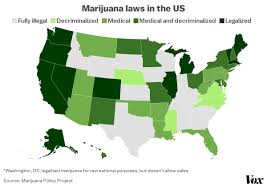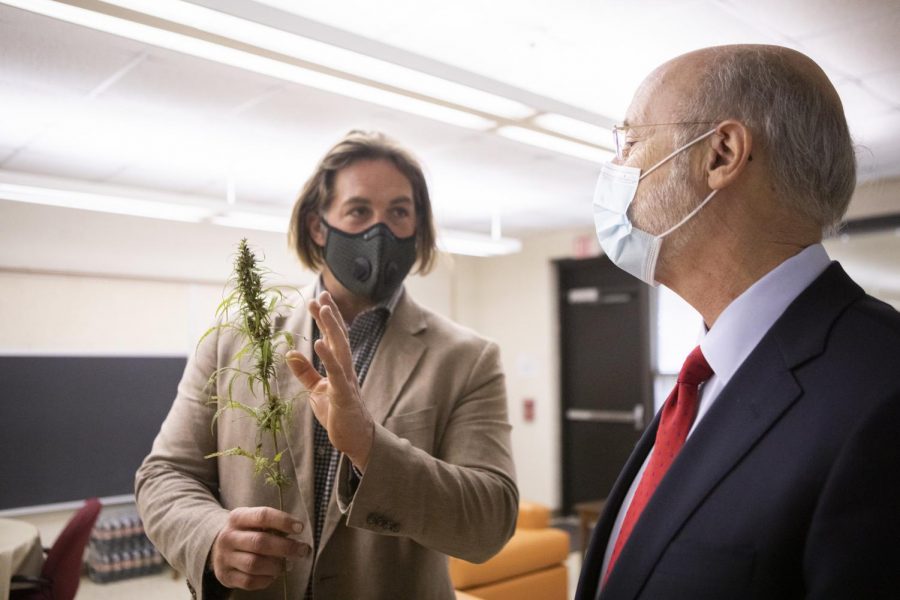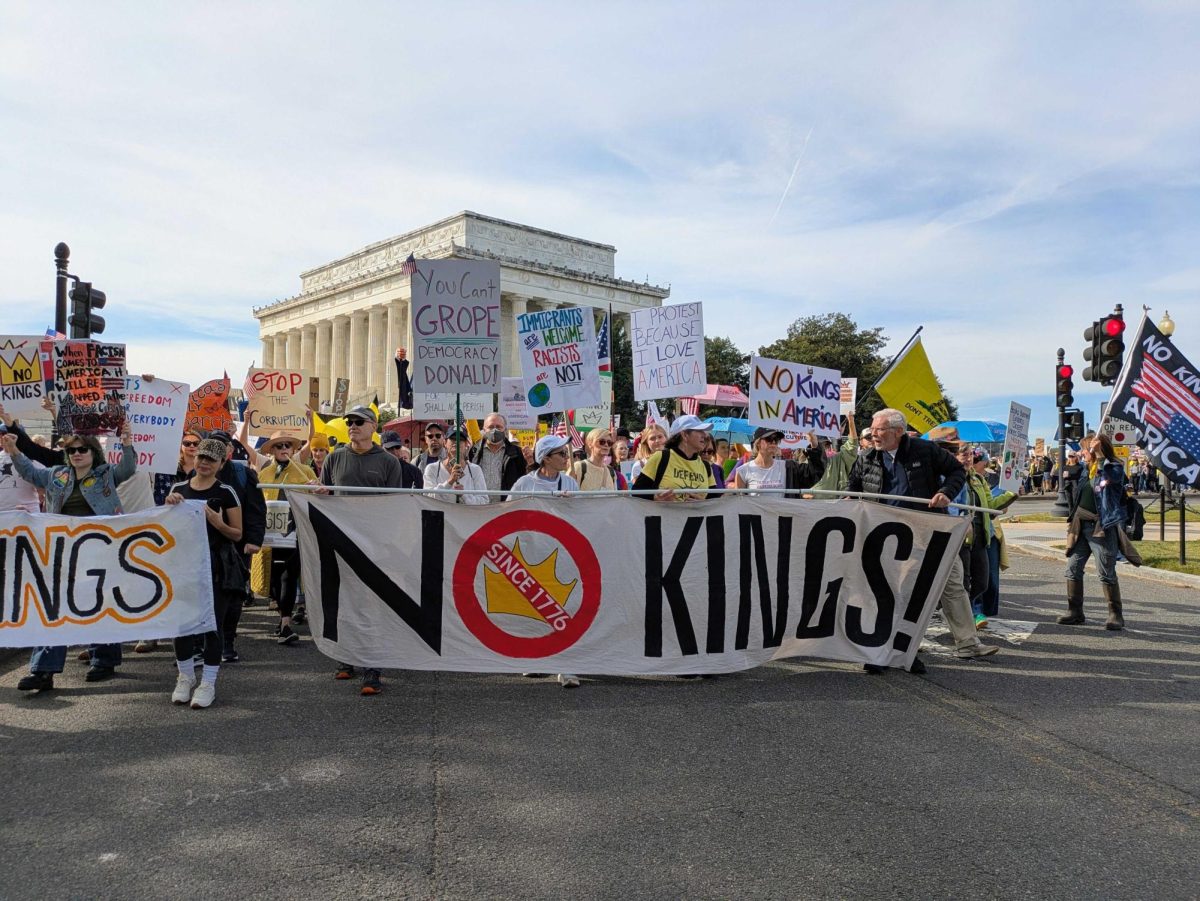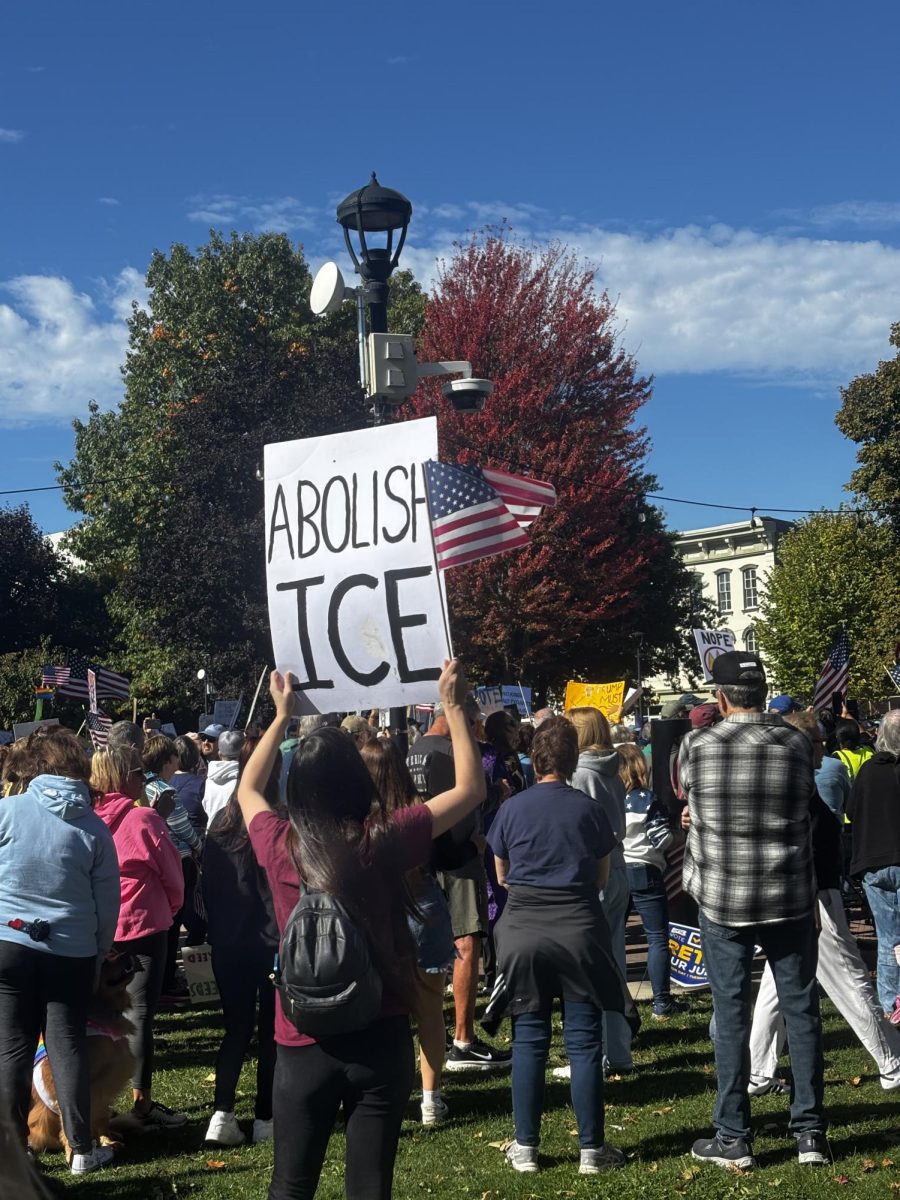Wolf calls for legalization of marijuana
Students, faculty weigh in on governor’s plan that implements restorative justice
Pennsylvania Gov. Tom Wolf, right, stands with Eric Titus White, a hemp farmer who is showing Wolf a cutting of industrial hemp as part of Wolf’s visit to Monroe County on Oct. 13. There, Wolf discussed the benefits of legalizing recreational marijuana, including economic growth and restorative justice benefits for incarcerated Pennsylvanians.
October 20, 2020
With plans to use the tax revenue to fund restorative justice programs, Pennsylvania Gov. Tom Wolf called for the legalization of recreational marijuana late last month. Legalization contributes to a more comprehensive plan that Wolf claims will aid the Pennsylvania economy, which has been hurting due to shutdowns since the outbreak of the COVID-19 pandemic.
In Wolf’s plan, restorative justice is the rehabilitation of illegal marijuana use offenders through reconciliation with both the victims and communities.
Parris Baker, Ph. D., a Gannon faculty member in both the social work and honors programs, gives a definition for restorative justice.
“Restorative justice philosophically de-emphasizes punishment and the singular focus on the offender,” Baker said. “Instead of punitive intervention, restorative justice provides an opportunity for the victim, the offender, and when culpable, the correction system to enter into a healing process for all involved parties.”
Christopher Magno, Ph. D., a professor in the criminal justice program at Gannon, offers another definition of restorative justice.
“The state was able to do harm to these people and they need to restore that harm by decriminalizing marijuana and releasing those in jail because of marijuana use and possession,” said Magno. “This is something called restorative justice. ”
Some believe that aside from aiding the economy, legalization will lead to a decrease in marijuana-related crimes and the crime rate in general.
But the issue of legalization is not as simple as it seems. As a multifaceted issue, many disagree on its practicality.
Baker believes it is only a matter of time before recreational marijuana is legalized. Since, according to Baker, legalization is inevitable, it is important to consider the restorative justice measures that need to be implemented after it occurs.
“When marijuana becomes legal in Pennsylvania, individuals who have been incarcerated for marijuana sale or possession with the intent to distribute should receive time served and participate in programs with a restorative justice emphasis or component,” Baker said.
“Restoration and restitution, in varied forms, should be part of the intervention plan. Other methods of legal intervention could contain an education component or more specifically, if marijuana becomes legal, have the records of the offender expunged related to the marijuana crime.”
According to former FBI agent Gerald Clark, Ph. D, criminal justice chairperson at Gannon, research regarding the correlation between crime and marijuana usage remains inconclusive. However, he believes common sense says that whenever a drug or substance is legalized and made available, a greater potential for abuse and addiction is introduced, which will inevitably impact the criminal justice system.
In many violent crimes, some involvement with drugs or a need for money to get drugs manifests. Addiction is a powerful thing, and when it comes to drugs, money continues the habit and feeds the addiction. Addiction results in constant seeking of the highest level of pleasure, and oftentimes individuals turn to illegal activity to come up with money.
“Anytime we are altering our systems it adds another variable,” Clark said.
On the other hand, Erie County District Attorney Jack Daneri believes that marijuana does not have much of an impact on crime. Especially when it comes to violent crime, which Daneri would not attribute to marijuana use at all. It does not factor into many cases in the District Attorney’s office, and when in conjunction with other, more substantial charges, the attorneys drop the marijuana or paraphernalia charges more often than not.
“On our list of crimes committed in this county, marijuana is off-the-chart low,” Daneri said. “It does not factor into our resolution or prosecution of people in this community.”
Daneri says that DUIs comprise 30% of the almost 4,000 cases in his office. Hardly any of these result from marijuana. Most DUI cases involve alcohol or other drugs. In Erie as well as many other places, marijuana use stands as such a low-level crime that the criminal justice system remains largely unconcerned with it. As a whole, the low penalties given for marijuana possession do not deter future offenses, so they do little to correct a user’s lifestyle.
While higher penalties can be implemented for dealing, they are insignificant when compared to the penalty for dealing other drugs. For dealing 1-10 pounds of marijuana, the punishment ranges from probation to a sentencing of nine months, while for dealing another drug, a punishment of years of jail time is often instituted. For dealing less than one pound of marijuana, one may face only probation.
“I don’t think there is a rush or connection between an increase in crime that concerns the majority of people in this county,” Daneri said.
However, Angela Bizzaro, a freshman biology major, said that not only are people arrested and imprisoned on account of marijuana charges, but also that the state is wasting substantial amounts of money on these cases.
“This is an issue about which most members of Congress are simply out of touch with their constituents, who know the difference between marijuana and more dangerous drugs, and who oppose spending $25,000 a year to jail an otherwise law-abiding marijuana smoker,” Bizarro said. “With that amount, on average, it costs about $195 a day to feed, clothe and provide sanitary services for the inmate.”
Bizarro also said that the current marijuana policy adversely affects people of color.
“While blacks and Hispanics make up only 20% of the illegal marijuana smokers in the U.S., they comprised 58% of the marijuana offenders sentenced under federal law,” Bizzaro said.
Also according to Bizzaro, the current policy regarding recreational marijuana can be more harmful than the use of recreational marijuana itself.
“Scientific evidence and thoroughly done research proves how marijuana laws are more obstructing than the actual drug itself,” Bizzaro said. “If marijuana were dangerous we would certainly know it; a significant segment of our population currently smokes marijuana recreationally, and there would be epidemiological evidence of harm among real people. No such evidence exists, despite millions smoking marijuana for years.”
According to Clark, the United States has adopted a humanistic view of pleasure, which contributes to the dumbing down of society. The legalization of recreational marijuana could potentially put society at risk.
“Let’s not keep lowering our standards just to keep ourselves happy,” Clark said. “What makes you happy should not be in drugs. Other nations in the world are powerful because they don’t allow it. I don’t know if legalization would keep us competitive.”
However, according to Daneri, marijuana does not have an adverse impact. It possesses lower addictive qualities with less overdoses; therefore, other drugs prevail as more of a priority to the criminal justice system. He also says that weed addicts do not look or act much different over time as compared to a methamphetamine or cocaine addict, who can appear unrecognizable after a number of years of use.
“You could give the legislature some points for recognizing that people having or dealing marijuana should not be treated the same as people having or dealing heroin,” Daneri said.
Clark believes legalization may snowball, and it becomes difficult to decipher where to draw the line.
“Where do we stop it?” Clark asked. “How do we determine that people don’t take advantage of it?”
Baker agrees with Clark and is concerned that there may be unintended consequences if marijuana is legalized.
“Marijuana remains a gateway drug, particularly with adolescent and young adults,” Baker said. “The gateway or path that leads to other drugs is increased the younger the user is initially. Marijuana use is usually accompanied with increased use of cigarettes, cigars and alcohol.”
But Daneri does not believe that legalization will have much of an impact on either the people already using or people who do not. If communities decriminalize marijuana, the people not previously using are not suddenly going to convert to frequent users, and the people who do use will use no matter what.
Much is to be considered from a financial standpoint. When looking at other states such as Washington and Colorado that legalized, they brought in $319 million and $266 million in tax revenue, respectively. These figures can be an enticing argument in the push for legalization, according to Wolf in a press release.
According to Nick Carneval, a junior finance major, the legalization of recreational marijuana would be beneficial in multiple areas.
“It would support local businesses, more agriculture and expansion of the service industry,” Carneval said.
Collin Bonner, a freshman digital media communications major, agrees.
“There is a large amount of money just waiting to be made by the states,” Bonner said.
However, Clark believes that if legalization occurs, it should not have monetary motivation. This could open the doorway to legalizing other potentially harmful substances for the sake of profit.
“It should never be for financial purposes or to benefit some other program.” Clark said.
Putting the tax revenue from marijuana toward restorative justice programs is not as necessary as it seems to be from Wolf’s proposed legislation. Implementing such programs would also be what Daneri calls “a logistical nightmare.” And with clean slate legislation and expungements already in place and possible, restorative justice possesses little relevance, and therefore does not need funding.
Aside from economic aspects, restorative justice measures abide as unnecessary because there is almost no one severely punished for marijuana possession. Daneri says that no inmates in the Erie County Prison were convicted on just marijuana charges. Therefore, the premise that a large number of people are unjustly punished for small, low-level marijuana charges proves largely inaccurate.
“I’m not sure how restorative justice goes along with marijuana because people’s lives today aren’t adversely affected, if at all, by a marijuana conviction,” Daneri said. “I don’t see marijuana being the ball and chain; it’s too easy a leap to make. It plays out well in the newspaper, but there’s always going to be a counter article.”
However, Magno disagrees. He believes there is a discrepancy between races in regards to punishments given for marijuana crimes.
“In terms of arrests, there are more African Americans being arrested compared to whites,” Magno said. “The discrepancy is high – for every 100 white people being arrested for marijuana use, there is something like 700 African Americans being arrested.”

It also begs the question of how recreational marijuana would be regulated. Medicinal marijuana is already legal and highly regulated, and it can be questioned if marijuana for recreational use would be regulated just as strictly. According to Clark, it would be best handled similar to alcohol – at a state level. In this way regulations and taxes are instituted, and it is easier to make sure safe marijuana is on the market that is not laced with more harmful substances. Right now, while recreational marijuana remains illegal, it is difficult to be certain of how the substance is made or even what is in it.
Even if recreational marijuana is adequately regulated, Clark believes illegal use will still exist. Users will always look for the lowest price point, and people may still turn to the black market. While legalization may lessen the influence of illegal cartels, it will not completely eradicate their presence.
“The supply and demand will always be there,” Clark said.
There may also manifest a need for reform in the criminal justice system with the legalization of recreational marijuana. Protocol may need changed for law enforcement for situations such as DUIs, when it would then be necessary to distinguish between the influences of alcohol and marijuana. A specific drug court may also need to be instituted so that the offense can be dealt with as an addiction, rather than going to the main court.
If legalization is to occur, Clark believes it should be uniform among all 50 states and dealt with at a federal level. There is a danger of transportation across state lines if all states are not unanimous in legalization, and there is also a confusing message to younger generations as to whether marijuana use is OK or not.
There is still a complicated message regarding marijuana use, whether it is legalized across all 50 states or not. With many opposing opinions and narratives, the impacts of marijuana use on individuals and communities still remains largely inconclusive. For now, it is up to individual discretion to decide whether legalization is actually something that, according to Wolf, will “help our economic recovery, it will help Pennsylvania families and it will help make our criminal justice system fairer.”
ANNA MALESIEWSKI






